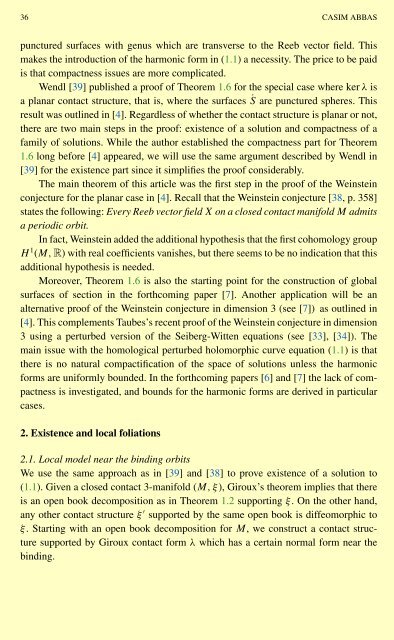NEAR OPTIMAL BOUNDS IN FREIMAN'S THEOREM
NEAR OPTIMAL BOUNDS IN FREIMAN'S THEOREM
NEAR OPTIMAL BOUNDS IN FREIMAN'S THEOREM
You also want an ePaper? Increase the reach of your titles
YUMPU automatically turns print PDFs into web optimized ePapers that Google loves.
36 CASIM ABBAS<br />
punctured surfaces with genus which are transverse to the Reeb vector field. This<br />
makes the introduction of the harmonic form in (1.1) a necessity. The price to be paid<br />
is that compactness issues are more complicated.<br />
Wendl [39] published a proof of Theorem 1.6 for the special case where ker λ is<br />
a planar contact structure, that is, where the surfaces ˙S are punctured spheres. This<br />
result was outlined in [4]. Regardless of whether the contact structure is planar or not,<br />
there are two main steps in the proof: existence of a solution and compactness of a<br />
family of solutions. While the author established the compactness part for Theorem<br />
1.6 long before [4] appeared, we will use the same argument described by Wendl in<br />
[39] for the existence part since it simplifies the proof considerably.<br />
The main theorem of this article was the first step in the proof of the Weinstein<br />
conjecture for the planar case in [4]. Recall that the Weinstein conjecture [38, p. 358]<br />
states the following: Every Reeb vector field X on a closed contact manifold M admits<br />
a periodic orbit.<br />
In fact, Weinstein added the additional hypothesis that the first cohomology group<br />
H 1 (M,R) with real coefficients vanishes, but there seems to be no indication that this<br />
additional hypothesis is needed.<br />
Moreover, Theorem 1.6 is also the starting point for the construction of global<br />
surfaces of section in the forthcoming paper [7]. Another application will be an<br />
alternative proof of the Weinstein conjecture in dimension 3 (see [7]) as outlined in<br />
[4]. This complements Taubes’s recent proof of the Weinstein conjecture in dimension<br />
3 using a perturbed version of the Seiberg-Witten equations (see [33], [34]). The<br />
main issue with the homological perturbed holomorphic curve equation (1.1) isthat<br />
there is no natural compactification of the space of solutions unless the harmonic<br />
forms are uniformly bounded. In the forthcoming papers [6] and[7] the lack of compactness<br />
is investigated, and bounds for the harmonic forms are derived in particular<br />
cases.<br />
2. Existence and local foliations<br />
2.1. Local model near the binding orbits<br />
We use the same approach as in [39] and[38] to prove existence of a solution to<br />
(1.1). Given a closed contact 3-manifold (M,ξ), Giroux’s theorem implies that there<br />
is an open book decomposition as in Theorem 1.2 supporting ξ. On the other hand,<br />
any other contact structure ξ ′ supported by the same open book is diffeomorphic to<br />
ξ. Starting with an open book decomposition for M, we construct a contact structure<br />
supported by Giroux contact form λ which has a certain normal form near the<br />
binding.

















